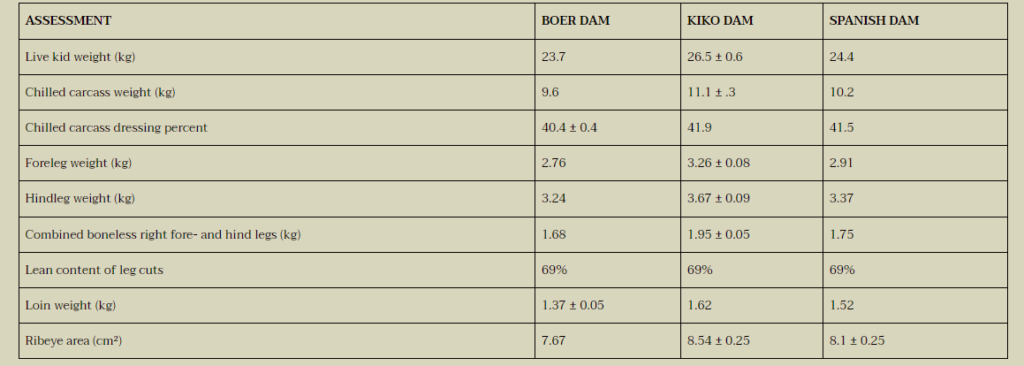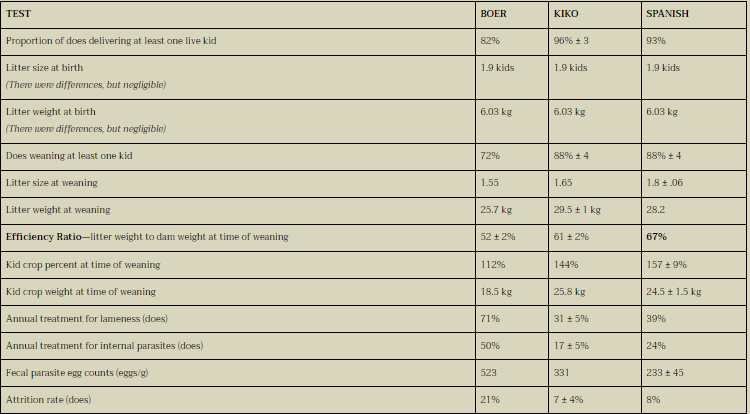Are Spanish goats the best breed out there?
Maybe. We like all types of goats here—to each their own. However, Spanish goats are extremely hardy.
We know that goat breeders need to research the facts to make informed decisions to choose or enhance their breeding stock, so we’ll help make it easy. We’re just starting to put study results of Spanish goats onto this site, so please be patient and check back for additional study results as they’re posted.
Carcass Weights
Information taken from the study: “Sire and dam breed effects on carcass characteristics of meat goat kids from a three-breed diallel.” by by R. Browning, Jr., W. Getz, O. Phelps, C. Chisley, Tennessee State University, Nashville, Tennessee, USA, Fort Valley State University, Fort Valley, Georgia, USA, USDA-AMS, Lakewood, Colorado, USA, Southern University, Baton Rouge, Louisiana, USA
This abstract is available as a pdf download at faculty.tnstate.edu/rbrowning/AtlantaCarcassAbstract.pdf
From 2005–2009, 275 buck kids from Boer, Kiko, and Spanish sires and dams were weaned at 13 weeks, raised on summer pasture with 0.4 kg/day of 16% pelleted feed, then harvested at 33 weeks of age.
The object was to determine whether the breed of parent effected the carcass weights of the kids. It seems that it did.
For starters, it was interesting to discover what the goats looked like from the perspective of the USDA people doing the grading.
When it came to visual live animal muscling grades, kids sired by Boers and Spanish were chosen over those sired by Kikos. And the visual chilled carcass muscling grading also showed a tendancy to select kids sired by Boers—kid carcasses coming from Boer sires were chosen over those from Spanish and Kiko sires. Interesting, because the breed of sire didn’t actually affect the kids’ live, carcass, or cut weights. Beauty is in the eye of the beholder, especially if there’s no scale handy.
When it came to live grades of kids, once again the Boers won out as kids with Boer dams were chosen over those from Spanish and Kiko dams. Carcasses from all three breeds of dam were graded equally.
So, the breed of sire didn’t make much difference in the kids. Let’s find out how the breed of dam affected how the kids did on the rack.

Kidney-pelvic fat weight was 74 ± 16 grams when both dam and sire were Boers, but for the other breeds (and crosses) it was between 127 and 164 grams.
Food for thought: although breed of dam affected the live, carcass, and cut weights, breed of sire did not affect these.
In short, if you want to increase the meat yield from your herd, changing your buck won’t be as effective as changing your does.
Doe performance: Comparing Boer, Kiko, and Spanish.
Information taken from the study: “Doe Reproductive and Fitness Traits Among Three Meat Goat Breeds Semi-intensively Managed in the Southeastern US” by R. Browning, Jr., M. L. Leite-Browning, B. Donnelly, and M. Byars, Tennessee State University, Nashville, Tennessee, USA
This information also appears at http://faculty.tnstate.edu/rbrowning/
In the fall of 2003–2005, 81 Boer, 64 Kiko, and 59 Spanish straightbred does were exposed to Boer, Kiko, and Spanish bucks in a complete 3-breed mating scheme to assess doe reproductive performance on southeastern US pastures. Does were managed together in a semi-intensive manner. Kids were weaned at three months. There were significant differences in doe performance. Litter sizes and weights were the same, but let’s find out how the does performed overall. .

That was good. . . we now know that Spanish goats put out more pounds of kids per pound of doe. We also know that Spanish goats can be taken from an arid climate (Texas) into Tennessee and still perform consistently well
Parasite Resistance
Information taken from the study: “Selection for Resistance in Goats Using Artificial Nematode Challenge” by Dzakuma, J.M., E.A. Wilson, N.C. Beckford, B.M. Johnson, and L.C. Nuti, International Goat Research Center, Prairie View A&M University, Prairie View, Texas, U.S.A.; and T.M. Craig, Dept. of Veterinary Pathobiology, Texas A&M University, College Station, Texas, U.S.A.
This paper is available in full as a pdf download at www.spanishgoats.org/pdf/dzakuma1.pdf
249 goats born in 2004 from Tennessee Stiff-legged (Myotonic), Spanish, and Boer breeds were divided into four treatment groups:
Two groups were challenged orally, with one large dose of 5,000, L3 stage infective Haemonchus contortus larvae (barber pole worms) per animal to evaluate the impact of management treatments. The other two groups were not artificially challenged.
The groups were maintained on pasture and on concrete, with or without artificial challenge.

The study shows that resistance to worms is affected by the breed of the goat. It seems that the Myotonics did just as well as the Spanish here.
Just a note of interest: if any kids couldn’t handle the test, they were removed from the study and promptly dewormed.
